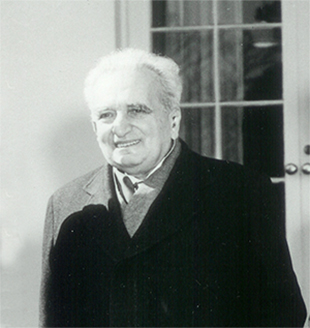

Theodore von Kármán (1881-1963)
“Scientists study the world as it is, engineers create the world that never has been.”
–Theodore von Kármán
National Medal of Science (NMS) recipient in 1962 “for his leadership in the science and engineering basic to aeronautics, for his effective teaching and related contributions in many fields of mechanics, for his distinguished counsel to the Armed Services, and for his promoting international cooperation in science and engineering.”
Theodore von Kármán was born in Budapest, Hungary, to a prosperous family. His mother came from a distinguished Bohemian family and his father was a well-known professor of education and philosophy. Von Kármán’s parents and brothers saw early on that he had talent in science and math and in 1897, he won a national competition for a science and mathematics scholarship. However, von Kármán’s father deemed his ability to do complex calculations in his head impractical and steered him toward other pursuits. Von Kármán said years later that because of this, he could “only multiply in Hungarian.”
Von Kármán graduated from the Minta Gymnasium, a school established by his father, and enrolled at the Palatine Joseph Polytechnic in Budapest. At his father’s wishes, he earned a bachelor’s degree in mechanical engineering. After a year in compulsory military service and several years teaching and consulting, von Kármán received a scholarship to the University of Göttingen in Germany.
During his last year of graduate school in 1908, von Kármán observed an airplane in flight during a trip to Paris. He moved in with “a group of bachelors,” including the physicist Max Born, and remained at Göttingen to explore the role of mathematics in aeronautics. His work there on what is now known as the Kármán Vortex Street and other aerodynamics problems garnered international attention.
In 1913, von Kármán joined the faculty at the Technical University in Aachen, Germany. He remained there until 1930, with a several year interruption to serve as director of research in the Austro-Hungarian Army Aviation Corps. Concerned about the rise of the Nazis in Germany, von Kármán accepted an offer to direct the new Daniel Guggenheim Aeronautical Laboratory at the California Institute of Technology in 1930, and brought his mother and sister with him to the United States. Von Kármán became a U.S. citizen several years after moving to the country.
In 1935, the laboratory began working on rocket design. Von Kármán suggested using the term “jet propulsion,” as most in the field still considered rockets an impossible technology. He played a significant role in advising the U.S. military on air power during World War II, and helped found numerous laboratories and organizations, including the Jet Propulsion Laboratory at Caltech and the NATO Advisory Group for Aerospace Research and Development. Von Kármán received the very first NMS shortly before he passed away while on a trip back to Aachen, Germany, in 1963. Though he never married, he enjoyed hosting students, colleagues, and visitors with his sister Josephine.
Image descriptions and credits
Any opinions, findings, conclusions or recommendations presented in this material are only those of the presenter grantee/researcher, author, or
agency employee; and do not necessarily reflect the views of the National Science Foundation.


